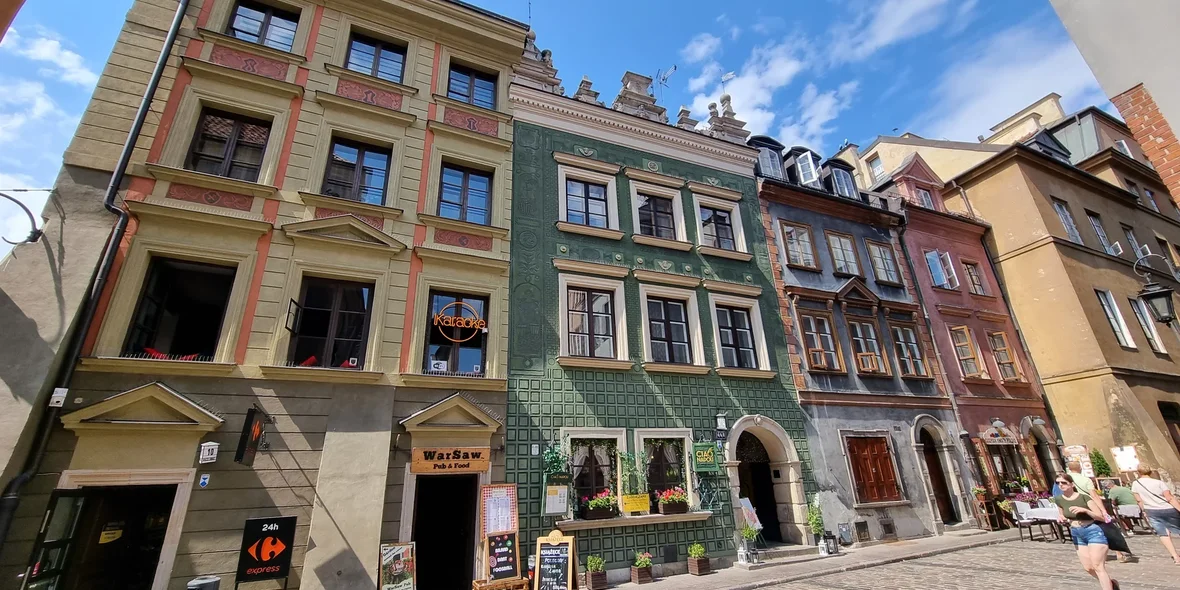
Is There Still Inexpensive Real Estate in Poland? Review of Current Prices and Mortgage Rates in an Interview with an Expert
Demand for Polish real estate continues unabated, and local realtors expect prices to rise further in the foreseeable future. To understand what is happening in the Polish real estate market, we talked with Natalia Zaitseva, CEO and realtor of Etalon Estate Group.
The most liquid options are purchased at the excavation stage.
About changes in real estate prices in Poland

— Over the past decades, prices have grown very systematically and constantly — about 8-10% per year. There were several small jumps: when the wave of emigration from Belarus and Ukraine began (up to 15% per annum), as well as in the summer of 2023, when Poland introduced a state program to support mortgage lending for first home buyers. This option was used not only by Poles but also by foreigners with a residence permit.
The upward trend in prices continues and, according to our forecasts, will continue for a long time. In 2024, a new bill on additional subsidies for mortgages is expected: that is, say, if a citizen takes out a mortgage at 7% per annum, the state will additionally finance most of this, and the person will need to pay the remaining 1-1.5% depending on marital status, income, and so on. This will also boost prices, demand, and supply availability in the market.
About the demand for different types of real estate
— The demand for Polish real estate was and is high for many reasons: it is one of the most inexpensive EU countries, with a high standard of living. Real estate here is still worth less compared to neighboring Germany.
Thanks to this, a wave of emigration rushed here. Today, many foreign companies open branches here and transport employees to optimize taxes.
The greatest demand is for two- and three-room apartments* in large cities — Poznań, Warsaw, Wrocław, Kraków, and Gdańsk. They are bought mainly for investment and rental, but also for your own living, of course, too.
The Poles themselves invest not only in local real estate, but also in properties in other countries, such as Spain and Cyprus.
*Two-room apartments are those with one bedroom (40-45 sq.m.), three-room apartments are those with two bedrooms (from 50 to 70 square meters).
Over the past year, prices have increased by 20–25%.
About sales volumes and prices for apartments in different cities
— In general, there is enough housing on the Polish market, although it should be noted that the most liquid options are purchased at the excavation stage. By the time the house is completed, only large, three-room apartments remain.
Over the past year, housing costs have increased by 20–25%; before that, the growth was about 8–10% per year. Warsaw has the highest real estate prices; Kraków is behind it in this ranking, followed by Gdańsk, Poznan, and Wrocław at approximately the same level.
I will give examples of prices for properties in Poznan: new buildings without finishing cost 10–14 thousand zlotys per sq.m (~$2500–$3500); on the secondary market, buildings with finishing cost 15–16 thousand zlotys. That is, for finishing, we always add about 2 thousand zlotys per meter (~$500).
In good areas, you can find finished apartments at the price of new buildings without renovation.
At the same time, on the secondary market, if you study the market well, you can find very liquid, high-quality options in good areas at the same price as from the developer (which will be without finishing). It’s just that houses with such apartments will be 8–15 years old.

— Rising prices have affected every type of real estate. The most expensive real estate in Poland are properties in the centers of large cities, in new luxury houses, sometimes in the suburbs (if made of expensive and high-quality materials), as well as restored kamenica (these are houses from the late 19th century in city centers with high ceilings).
Houses built between 1950 and 1980 were the slowest to rise in price in our market. That is, if apartments in 2023 increased in price by 20%, then in this segment, by 10-12%.
You can also buy cheaper property in the suburbs of big cities and in fairly good residential complexes, but it is only suitable for your own residence; it is not entirely suitable for investors due to the low demand for rentals.
About buying housing by foreigners
— Real estate in Poland is absolutely accessible to everyone — there is no difference in its registration, whether a Pole or a foreigner buys it. But there are nuances when it comes to land.
The fact is that foreigners cannot buy land plots, houses on such plots, commercial real estate, and properties in border zones without special permission from the Ministry of Internal Affairs. To obtain such a permit, you need to prove your connection with Poland (have a residence card, a Pole card, or run a business in the country), as well as indicate the source of origin of the funds (whether it is a mortgage, money earned in Poland or another country, etc.).
It is important to consider that at the time of submitting your application to the department, you must have already selected and booked the property and concluded a preliminary agreement with the owner, who, in turn, must agree to wait until you receive such permission. Typically, this entire process takes from 3 months to a year.
If you don’t want to wait or don’t have the opportunity, you can find other options: for example, buy a house in Poland through a company opened in the country, or buy a townhouse — the same house, only without being tied to the land (in this case, it is simply in use by the owner).
About interest rates and their impact on the market
— As for a mortgage, foreigners can take it out if they have a residence permit (even temporary) and a stable income in Poland. They will also check your marital status, income, presence of dependent children, and so on — there are quite a lot of nuances.
The interest rate in Poland consists of the rate of a specific bank (about 1.5-2%) and WIBOR, the refinancing rate set by the state. Just 2–3 years ago, WIBOR was close to zero, which allowed banks to increase their rates and earn more; at that time, general rates were at 3.5%. Then the refinancing rate increased, and now the general rate is about 7-8%, depending on the bank.
We hope that the refinancing rate will decrease and the availability of loans will increase. At the same time, as I already said, the state is constantly coming up with something for its citizens, for example, it regularly launches mortgage subsidization programs.
About taxes when buying and owning real estate
— When purchasing on the secondary market, a tax of 2% of the cost is paid; there is no tax on the primary market. At the same time, in the secondary market, there is a benefit for those who buy their first home.
When owning, you need to pay an annual low land tax — about 200 zlotys per year (about 50 dollars) for a standard apartment. It is calculated individually for each property in the city administration immediately after purchasing the property.
About buyers and tenants
— There are several categories of foreigners buying property in Poland.
The first are foreigners from the countries of the former CIS, who usually first rent housing, and then, having got a job and received a residence permit, buy an apartment with a mortgage. The loan payment is the same, plus or minus, as in the case of rent.
There are foreign investors who buy, including remotely, apartments for their subsequent rental.
And there are those who, after much deliberation, decide to immigrate to Poland — they most often buy large three-room apartments or townhouses in the suburbs and already move here for permanent residence.
Most foreigners rent housing in Poland. Most often, these are programmers from the former CIS countries (especially from Belarus), students, and families who do not have a residence permit or are planning to move to another country.
By the way, rental rates recently fell to their previous level after a jump of 1.5–2 times in 2022, which occurred due to a wave of emigration from Ukraine.
Now in Poznan, you can rent a studio for 1800–2200 zlotys ($450–$550), a two-room apartment for 2500–3000 zlotys ($620–$750), or a three-room apartment for 3500–4000 zlotys ($870–$1000). All this does not include utilities. In Warsaw, it will be 30–40% more expensive. Rates vary greatly by area and level of home.
Forecasts and recommendations for buyers
We expect a systematic increase in prices and an even greater increase in demand from foreigners, including Germans, investing in cheaper Polish real estate. Over time, the Polish market will probably catch up with the German market in terms of prices. At least, that's what analysts think.
If a foreigner wants to purchase real estate but does not yet have the full amount, I would not recommend postponing the purchase, as prices are constantly rising. You can take advantage of an installment plan from the developer during the construction stage — pay 30% and pay the rest in installments before the house is delivered. This amount is not subject to any interest. This is an absolutely safe option — the rights of the buyer are protected in Poland more than the rights of the developer.
Here, when buying an apartment on the primary market, a targeted blocked bank account is opened, where the money is received and paid by the buyer, and it is issued to the developer only at the moment when he has completed a certain stage of work. That is, the developer built 30% of the object and received 30% of the total amount in his own account. All contracts are concluded by a notary, and immediately after signing, an entry is made in the State Register.
There are long-term construction projects, but there are not many of them – about 5%. You can minimize such risks by having a good understanding of the market and knowing the reputation of developers. I would recommend either thoroughly studying the market yourself, or contacting a professional realtor.
Although licensing of real estate activities in Poland is completely optional, I would still recommend paying attention to it. In order to obtain such a license, you need to pass a fairly complex exam in law and have knowledge of legislation related to real estate. A list of licensed agencies and agents can be requested from the Polish Real Estate Federation.
Author
I am responsible for editorial work. I write expert interviews and guides.























